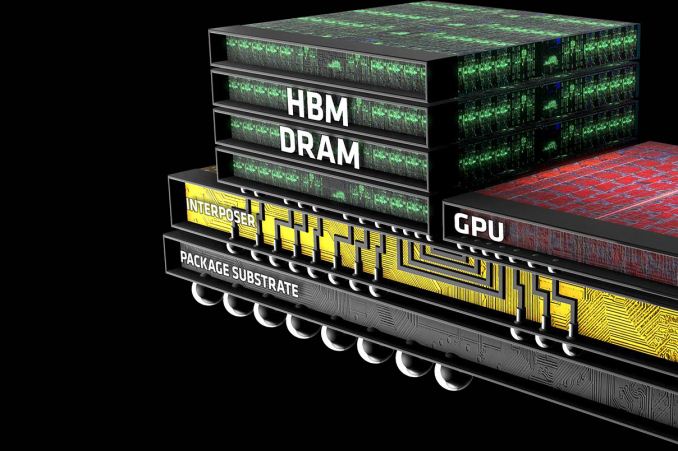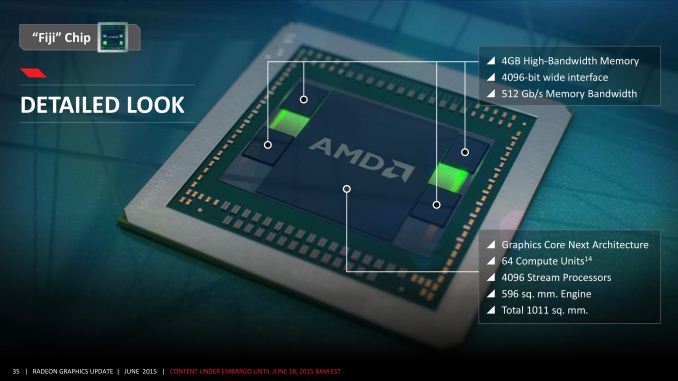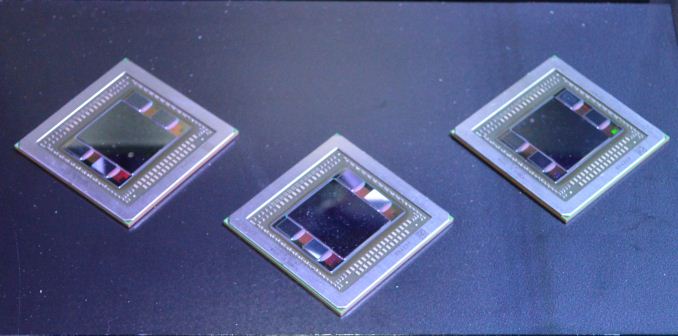The AMD Radeon R9 Fury X Review: Aiming For the Top
by Ryan Smith on July 2, 2015 11:15 AM ESTThe Fiji GPU: Go Big or Go Home
Now that we’ve had a chance to take a look at the architecture backing Fiji, let’s talk about the Fiji GPU itself.
Fiji’s inclusion of High Bandwidth Memory (HBM) technology complicates the picture somewhat when talking about GPUs. Whereas past GPUs were defined by the GPU die itself and then the organic substrate package it sits on, the inclusion of HBM requires a third layer, the silicon interposer. The job of the interposer is to sit between the package and the GPU, serving as the layer that connects the on-package HBM memory stacks with the GPU. Essentially a very large chip without any expensive logic on it, the silicon interposer allows for finer, denser signal routing than organic packaging is capable of, making the ultra-wide 4096-bit HBM bus viable for the first time.
We’ll get to HBM in detail in a bit, but it’s important to call out the impact of HBM and the interposer early, since they have a distinct impact on how Fiji was designed and what its capabilities are.
As for Fiji itself, Fiji is unlike any GPU built before by AMD, and not only due to the use of HBM. More than anything else, it’s simply huge, 596mm2 to be precise. As we mentioned in our introduction, AMD has traditionally shied away from big chips, even after the “small die” era ended, and for good reason. Big chips are expensive to develop, expensive to produce, take longer to develop, and yield worse than small chips (this being especially the case early-on for 40nm). Altogether they’re riskier than smaller chips, and while there are times where they are necessary, AMD has never reached this point until now.
The end result is that for the first time since the unified shader era began, AMD has gone toe-to-toe with NVIDIA on die size. Fiji’s 596mm2 die size is just 5mm2 (<1%) smaller than NVIDIA’s GM200, and more notably still hits TSMC’s 28nm reticle limit. TSMC can’t build chips any bigger than this; Fiji is as big a chip as AMD can order.
| AMD Big GPUs | ||||
| Die Size | Native FP64 Rate | |||
| Fiji (GCN 1.2) | 596mm2 | 1/16 | ||
| Hawaii (GCN 1.1) | 438mm2 | 1/2 | ||
| Tahiti (GCN 1.0) | 352mm2 | 1/4 | ||
| Cayman (VLIW4) | 389mm2 | 1/4 | ||
| Cypress (VLIW5) | 334mm2 | 1/5 | ||
| RV790 (VLIW5) | 282mm2 | N/A | ||
Looking at Fiji relative to AMD’s other big GPUs, it becomes very clear very quickly just how significant this change is for AMD. When Hawaii was released in 2013 at 438mm2, it was already AMD’s biggest GPU ever for its time. And yet Fiji dwarfs it, coming in at 158mm2 (36%) larger. The fact that Fiji comes at the latter-half of the 28nm process’s life time means that such a large GPU is not nearly as risky now as it would have been in 2011/2012 (NVIDIA surely took some licks internally on GK110), but still, nothing else we can show you today can really sell the significance of Fiji to AMD as much as the die size can.
And the fun doesn’t stop there. Along with producing the biggest die they could, AMD has also more or less gone the direction of NVIDIA and Maxwell in the case of Fiji, building what is unambiguously the most gaming/FP32-centric GPU the company could build. With GCN supporting power-of-two FP64 rates between 1/2 and 1/16, AMD has gone for the bare minimum in FP64 performance that their architecture allows, leading to a 1/16 FP64 rate on Fiji. This is a significant departure from Hawaii, which implemented native support for ½ rate, and on consumer parts offered a handicapped 1/8 rate. Fiji will not be a FP64 powerhouse – its 4GB of VRAM is already perhaps too large of a handicap for the HPC market – so instead we get AMD’s best FP32 GPU going against NVIDIA’s best FP32 GPU.
AMD’s final ace up their sleeve on die size is HBM. Along with HBM’s bandwidth and power benefits, HBM is also much simpler to implement, requiring less GPU space for PHYs than GDDR5 does. This is in part due to the fact that HBM stacks have their own logic layer, distributing some of the logic on to each stack, and furthermore a benefit of the fact that the signaling logic that remains doesn’t have to be nearly as complex since the frequencies are so much lower. 4096-bits of HBM PHYs still takes up a fair bit of space – though AMD won’t tell us how much – but it’s notably lower than the amount of space AMD was losing to Hawaii’s GDDR5 memory controllers.
The end result is that not only has AMD built their biggest GPU ever, but they have done virtually everything they can to maximize the amount of die space they get to allocate to FP32 and rendering resources. Simply put, AMD has never reached so high and aimed for parity with NVIDIA in this manner.
Ultimately this puts Fiji’s transistor count at 8.9 billion transistors, even more than the 8 billion transistors found in NVIDIA’s GM200, and, as expected, significantly more than Hawaii’s 6.2 billion. Interestingly enough, on a relative basis this is almost exactly the same increase we saw with Hawaii; Fiji packs in 43.5% more transistors than Hawaii, and Hawaii packed in 43.9% more transistors than Tahiti. So going by transistors alone, Fiji is very much to Hawaii what Hawaii was to Tahiti.
Finally, as large as the Fiji GPU is, the silicon interposer it sits on is even larger. The interposer measures 1011mm2, nearly twice the size of Fiji. Since Fiji and its HBM stacks need to fit on top of it, the interposer must be very large to do its job, and in the process it pushes its own limits. The actual interposer die is believed to exceed the reticle limit of the 65nm process AMD is using to have it built, and as a result the interposer is carefully constructed so that only the areas that need connectivity receive metal layers. This allows AMD to put down such a large interposer without actually needing a fab capable of reaching such a large reticle limit.
What’s interesting from a design perspective is that the interposer and everything on it is essentially the heart and soul of the GPU. There is plenty of power regulation circuitry on the organic package and even more on the board itself, but within the 1011mm2 floorplan of the interposer, all of Fiji’s logic and memory is located. By mobile standards it’s very nearly an SoC in and of itself; it needs little more than external power and I/O to operate.













458 Comments
View All Comments
Kristian Vättö - Thursday, July 2, 2015 - link
Just to add, if there are any ideas of keeping you guys better informed, please fire away. In the meantime, Twitter is probably the best way to stay updated on whatever each one of us is doing :)chizow - Thursday, July 2, 2015 - link
I think a pipeline story would've been good there, I mean using social media to convey the message to readership that may not even pay attention to it (I don't even think twitter sidebar shows on my iPhone 6 plus) is not a great way to do things.A few words saying the review would be late for XYZ reasons with a teaser to the effect of "but you can see the results here at 2015 AT Bench" would've sufficed for most and also given assurance the bulk of testing and work was done, and that AT wasn't just late for XYZ reasons.
Refuge - Friday, July 3, 2015 - link
I've never tweeted in my life.Yet I saw 4 seperate times last week where it was mentioned that Ryan was sick, and the Fury X review was coming as soon as he felt better.
chizow - Friday, July 3, 2015 - link
Where did you read this news though? Some forum thread? Twitter sidebar? I mean I guess whne everyone is looking for a front page story for the review, something in the actual front page content might have been the best way to get the message across. Even something as simple as a link to the bench results would've gone a long way to help educate/inform prospective buyers in a timely manner, don't you think? Because at the end of the day, that's what these reviews are meant for, right?Ian Cutress - Friday, July 3, 2015 - link
Twitter sidebar, the first line in the review that ended on the front page on the day of launch and in the comments for every review since launch day.testbug00 - Sunday, July 5, 2015 - link
Not everyone reads comments, and, the twitter feed is not viewable on my Six Plus. And likely not for anyone viewing on a phone and some tablets.chizow - Sunday, July 5, 2015 - link
Yeah, all non-ideal for anyone actually looking for the review, those just make it seem more like AT was trying to hide the fact their Fury X review wasn't ready despite there being no reason and a legitimate reason for it.Again, even a pipeline story with Ryan being sick and a link to the bench results would've been tons better in informing AT's readership, but I guess we'll be sure to comb through half conversations and completely unrelated comments in the future to stay informed.
Digidi - Thursday, July 2, 2015 - link
Thank you for the good Review. The only thing which i'm missing is a synthetic Benchmark of the polygon outpout rate. Because this seams to be the bottleneck of Fury XRyan Smith - Thursday, July 2, 2015 - link
We do have TessMark results in the synthetics section. You would be hard pressed to hit the polygon limit without using tessellation to generate those polygons.Digidi - Friday, July 3, 2015 - link
Thank you Ryan for the reply.I don't understand the difference between Tesselation and Polygonoutput. I thought there are 2 ways of polyogon Output.
1. is tesselation where the gpu integrates smaller triangles into a big triangle
2. I thought Polygonoutput is the rate of triangles which the gpu can handle when they get it from the cpu.